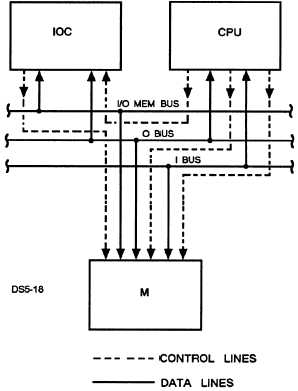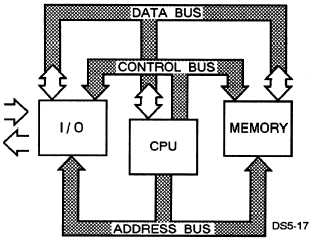memory at the address defined by the address bus or
consists of data read from the memory address specified
by the address bus.
Figure 5-17 is an example of a computer’s bus
system; control, address, and data buses.
Instruction (I) Bus
The instruction (I) bus allows communication
between the CPU and memory. It carries to the CPU
the program instruction words to be operated on by the
CPU from memory or returns instructions to memory.
The I bus is controlled by the CPU. It is capable of
sending or receiving data while the operand(O) bus is
receiving or sending data at the same time, but only in
one direction at a time.
Operand (O) Bus
The operand (O) bus allows communication
between the CPU and memory or the CPU and an I/O
Controller (IOC). The CPU controls the operation in
both cases. The O bus is capable of sending or receiving
data, while the I bus is receiving or sending data at the
same time, but only in one direction at a time. The
direction of the data depends on whether the CPU is
reading data from memory or data is being written back
into memory.
I/O MEM Bus or Input/Output Controller
(IOC) BUS
The I/O memory bus allows communication
between an I/O controller (IOC) and memory. It is
Figure 5-17.—Example of a computer’s bus system; control,
address, and data buses.
controlled by the IOC. To respond to the CPU, the I/O
MEM bus must use the O bus.
Figure 5-18 is an illustration of communications
between a CPU, memory, and an IOC without a
computer interconnection system. Pay close attention
to the direction of signal flow and which buses allow
communication between functional areas.
Computer Interconnection System
The Computer Interconnection System (CIS)
provides the complete functional replication of the
computer intraconnection among CPUs, IOCs, and
memories in separate computers. This allows the
internal buses to be extended beyond their own
enclosure. The CIS consists of two independent halves:
the requestor extension interface (REI) and the direct
memory interface (DMI).
REQUESTOR EXTENSION INTERFACE
(REI).— The requestor extension interface (REI) is a
bus extender. It extends the bus up to 15 other computer
cabinets providing an interconnected system of
memory modules, CPUs, and IOCs. The REI takes the
requests from the requestor ports and goes through a
priority network to determine the order in which it is to
respond to the requestors. Once the REI has responded
to a request, it puts the address onto the output bus,
Figure 5-18.—Bus system between a CPU, memory, and IOC
without CIS.
5-25




